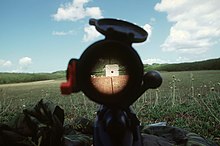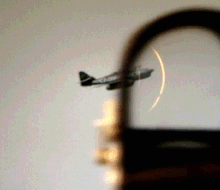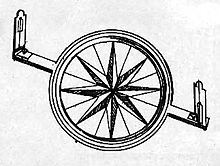Sight (device)

Asightorsighting deviceis anydeviceused to assist in precisevisualalignment (i.e.aiming) of weapons,surveyinginstruments, aircraft equipment,[1][2]optical illumination equipment or larger optical instruments with the intended target. Sights can be a simple set or system of physical markers that serve as visual references for directly aligning the user'sline of sightwith the target (such asiron sightsonfirearms),[3]oroptical instrumentsthat provide an optically enhanced—oftenmagnified—target image aligned in the samefocuswith anaiming point(e.g.telescopic,reflectorandholographic sights). There are also sights that actively project an illuminated point of aim (a.k.a. "hot spot" ) onto the target itself so it can be observed by anyone with a direct view, such aslaser sightsandinfraredilluminators on somenight vision devices,[citation needed]as well asaugmentedor evenvirtual reality-enableddigital cameras( "smart scopes" ) with softwarealgorithmsthat producedigitally enhancedtarget images.
Iron sights
[edit]
At its simplest, a sight typically has two components, front and rear aiming pieces that have to be lined up. Sights such as this can be found on many types of devices including weapons,surveyingand measuring instruments, and navigational tools.
On weapons, these sights are usually formed by rugged metal parts, giving them the name "iron sights",[4]as distinct from optical or computing sights.[5]On many types of weapons they are built-in and may be fixed, adjustable, or marked forelevation,windage,target speed, etc.[3]They are also classified in forms of notch (open sight) or aperture (closed sight). These types of sights can require considerable experience and skill, as the user has to hold proper eye position and simultaneously focus on the rear sight, the front sight, and a target, all at different distances, and align all threeplanes of focus.[6]
Optical sights
[edit]
Optical sights useopticsthat give the user an enhanced image with an aligned aiming point or pattern (also called areticle)superimposedonto the target image, preferably at the samefocal plane.
Telescopic sights
[edit]Atelescopic sightis arefracting telescopeequipped with some form ofreferencingpattern (reticle) mounted in an optically appropriate position in the optical system to give an accurate aiming point. Telescopic sights are used on a wide range of devices includingguns,surveyingequipment, and even as sights on larger telescopes (called afinderscope).
Reflector sights
[edit]
Another type of optical sight is thereflector (or "reflex") sight,a generally non-magnifyingoptical device that allows the user to look through a glass element and see a reflection of an illuminated aiming point or some other image superimposed on thefield of view.[7]These sights have been around for over 100 years and have been used on all types of weapons and devices.
Reflector sights were first used as a weapon sight in German aircraft towards the end ofWorld War I.Over the years they became more sophisticated, adding lead computing gyroscopes and electronics (theWorld War IIGyro gunsight)[8]radar range finding and other flight information in the 1950s and 1960s, eventually becoming the modernhead-up display.
Other types of optical sights
[edit]- Collimator sight
- Holographic weapon sight
- Laser sight
- Red dot magnifierused in conjunction with a non-magnified optical sight
List of sights
[edit]
There are many types of sighting devices. They can be fixed, mechanical, optical,computational,or a mixture of all of these attributes.
- Bombsight
- Collimator sight
- Diopter sight
- Globe sight
- Head-up display
- Holographic weapon sight
- Iron sight
- Laser sight
- Reflector sight
- Telescopic sight
- Thermal weapon sight
- Night vision device
- Fire-control system
See also
[edit]Notes
[edit]- ^"TESS:: David Gledhill".www.david-gledhill.co.uk.Archivedfrom the original on 2024-07-30.Retrieved2023-07-28.
- ^"The Way of the J. – British Phantom Aviation Group".Archivedfrom the original on 2021-10-24.Retrieved2023-07-28.
- ^abPatrick Sweeney (2004).Gunsmithing – Pistols & Revolvers.Krause Publications. p. 185.ISBN978-0-87349-763-3.[permanent dead link]
- ^Richard Bowyer (1999).Dictionary of Military Terms.Taylor & Francis. p. 178.ISBN978-1-57958-156-5.Archivedfrom the original on 2024-07-30.Retrieved2016-10-13.
- ^merriam-webster.com - iron sight -a metallic sight for a gun as distinguished from a sight depending on an optical or computing system[dead link]
- ^Dan Shideler (2010).Gun Digest 2011.F+W Media. p. 148.ISBN978-1-4402-1561-2.[permanent dead link]
- ^Elementary Optics and Application to Fire Control Instruments.Headquarters, Department of the Army. 1977. pp. 8–27, 8–28.Archivedfrom the original on 2024-07-30.Retrieved2016-10-13.
- ^"View from the line".Archivedfrom the original on 2011-07-18.Retrieved2007-09-11.
